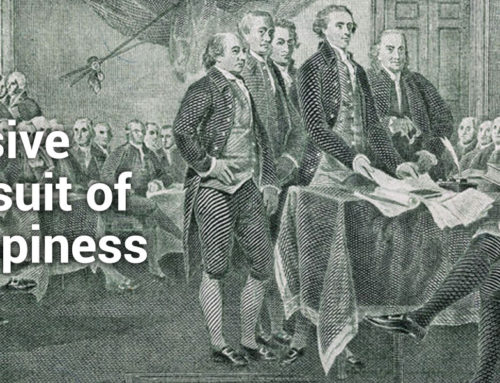In previous blogs, I have presented a comprehensive model of leadership that I have labeled The Performance Trilogy®. The framework describes the three fundamental processes that must be managed (read more) and the three leadership roles needed for each process (read more).
The first process is developing a winning strategy that is well thought out, compelling, and well communicated. In most cases you will be asking your staff, be it a small team or large organization to make changes and take considerable risks based on your word that the strategy will be successful. This will require considerable faith by your team. By faith, I mean believing in something, which you cannot prove. Asking scientists and engineers to believe in your vision and strategy with no direct evidence is a tremendous challenge (link to Blog#3). Only when your team has faith in your strategy and a “shared vision” of the ultimate destination can you confidently proceed to the execution phase. Too often, potential leaders make the mistake of moving forward prematurely with skeptical team members and then wonder why they fail in executing the strategy, often blaming their team rather than themselves. Before trying to execute your strategy, you should ask yourself three critical questions and have rock solid answers from your team before moving on to execution.
Is the destination desirable?
It is important that the destination (or vision) be highly desirable. In order to get inspired by any initiative, be it a personal, team, or institutional one; the proposed endeavor needs to provide meaning and purpose not only to you and your superiors, but to the team that needs to execute. So, it is not only important to describe “what” the final end point is, but more importantly “why” it’s important and urgent enough that it is worth pursuing. In Kotter’s book, Leading Change, he points out that the lack of a sense of urgency and shared vision among team members are two of the major causes of failed endeavors. In order to inspire your team to leave their comfort zone and commit to a new strategy, you need to explain why achieving the vision will be important, meaningful and worthwhile.
Human nature tells us that there are basically two major reasons why people are willing to make substantial changes in life: the first is through inspiration and the second is through desperation. Examples abound of people who have been inspired to take up causes due to the death of a family member or social injustice. While the meaning and purpose of your vision may not be as dramatic, the more thought that goes into its meaning and purpose, the more willing your team will be to embrace the changes that may be necessary to get there. I encourage you to view the TED talk by Simon Sinek to see the power of “why”.
Alternatively, although not quite as impactful, you may need to point out what the consequences might be if you don’t pursue your initiative. Examples of major changes caused by desperation include quitting smoking after a heart attack and using seat belts after seeing the consequences of a major accident. Once again, while the downside of not taking action on your initiative may not be quite as dramatic; the loss of independence, resources, pay raises, bonuses or even job loses may influence your team to buy into and support the necessary changes.
Is the destination achievable?
Once you have convinced your team that the destination is highly desirable, you then need to convince them that the path chosen (strategy) has a reasonable chance of getting you there. Asking team members to accept and follow your strategy oftentimes involves considerable risks. To ask them to leave their comfort zones and take on such risks requires you to convince them that your strategy is well thought out and you and the team have the talent, ambition, skills and knowledge necessary to successfully execute the strategy. The strategy needs to be highly specific including a roadmap and action plan detailing each of the required steps. Potential barriers need to be identified and actions identified to overcome them.
Oftentimes, bright and talented potential leaders make critical mistakes in developing strategy due to ignorance, arrogance or both. Ignorance is displayed most often in a lack of understanding of client or stakeholder needs and desires. Too often assumptions are made without obtaining the information directly from the clients or stakeholders. Also, competitor’s strengths are often underestimated due to lack of information. Arrogance is often displayed in overestimating the strengths of the team as well as the resources that might be available within the organization. Even worse, valuable information is ignored because it doesn’t support the strategy.
It is important to be willing to have your strategy challenged by your team members. The more questions that you can answer to their satisfaction, the more confidence they will develop in you. Questions that you cannot answer will point out potential weaknesses to the strategy that need to be shored up through more information or backup plans. Rigorous examination by your team as well as trusted advisors will strengthen the strategy and increase the probability of success.
Is the destination beneficial?
If you have answered the first two questions well, the majority of your team members are beginning to overcome their skepticism and believe that the destination is indeed desirable (shared vision) and that the path chosen (strategy) has a reasonable chance of succeeding. Too many potential leaders assume that the strategy phase is completed at this point and move on to execution. They never get to the third question that needs to be answered; how will the initiative, if successful, benefit each of the team members?
As the leader, you are acutely aware of how success will benefit you and the credit that will accrue to you as the creator and leader. But each of the team members have their own desires about what they wish to gain from providing their support. It always amazes me how often leaders just guess and misread their team’s needs. It is always worth remembering that people do things for their reasons not yours. Spending time with each of your key team members to determine what are their aspirations and how this assignment may fulfill them may be the single most important activity that you can conduct during the strategy phase. This is the only way to win over their hearts and minds. Explore both extrinsic and intrinsic rewards that your team members are expecting and make realistic commitments to them based on the performance you expect. Also discuss potential risks that they may be taking and ways to mitigate them.
Only when you are confident that you have successfully answered all three questions in the minds of each of your key team members should you proceed to the execution phase. For organizational initiatives, you and your team will need to develop a more formal communication plan where these three questions are openly discussed among the wider audience. This is easier said than done. Suffice it to say that in my 45 years of organizational life, I’ve never once seen a strategy over-communicated!
To inspire faith in your strategy, you must LEAD.
Graffeo and Associates is an organization committed to improving the quality of leadership in science and technology (S&T). It was formed in 2008 around the expertise of Dr. Tony Graffeo, a senior executive from Arthur D. Little and Battelle Memorial Institute. Dr. Graffeo has consulted with leading research institutions in the United States, Europe, Latin America and the Middle East, and has created a codified system of leadership development centered around the principles of the Performance Trilogy® which he has taught throughout the world. He is currently a professor at Northeastern University teaching Professional Masters entrepreneurship and leadership courses. His new book, titled “Leading Science & Technology-Based Organizations: Mastering the Fundamentals of Personal, Managerial, and Executive Leadership” will be published in 2018.



